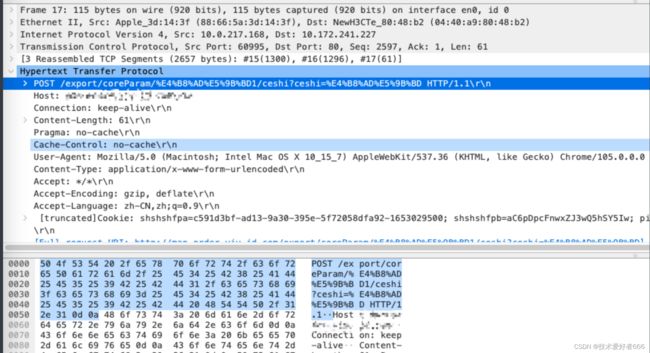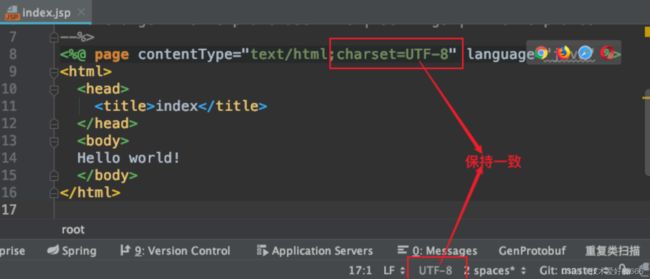Tomcat处理请求的编解码
Tomcat处理请求的编解码
文章目录
- Tomcat处理请求的编解码
-
- 前言
- 结论
- http请求的处理
-
- tomcat处理请求行以及请求体的参数
- spring处理请求行的path参数
- CharacterEncodingFilter的生效流程
- http响应处理
-
- 普通的页面渲染的场景
- spring中的@ResponseBody标注的返回值
前言
本文只分析tomcat与spring结合chrome浏览器的使用
结论
- chrome发送请求时请求行以及post请求体中的编码为utf-8
- chrome发送请求时请求头中的编码一定是ISO-8859-1
- 前端发送请求时,指定请求体的编码为utf-8
- tomcat处理请求行的参数时默认编码是ISO-8859-1
- spring处理请求行的path参数时的默认编码是ISO-8859-1
protected String determineEncoding(HttpServletRequest request) {
String enc = request.getCharacterEncoding();
if (enc == null) {
enc = getDefaultEncoding();
}
return enc;
}
protected String getDefaultEncoding() {
return this.defaultEncoding;
}
private String defaultEncoding = WebUtils.DEFAULT_CHARACTER_ENCODING;
public static final String DEFAULT_CHARACTER_ENCODING = "ISO-8859-1";
- tomcat处理请求体的参数时默认编码是ISO-8859-1
- tomcat处理请求行中的参数以及请求体中的参数的编码是相同的
- tomcat中使用org.springframework.web.filter.CharacterEncodingFilter时,请求行的path参数、请求行的参数以及请求体的参数都是指定的encoding的编码格式
<filter>
<filter-name>CharacterEncodingFilter</filter-name>
<filter-class>org.springframework.web.filter.CharacterEncodingFilter</filter-class>
<init-param>
<param-name>encoding</param-name>
<param-value>utf-8</param-value>
</init-param>
</filter>
<filter-mapping>
<filter-name>CharacterEncodingFilter</filter-name>
<url-pattern>/*
- 响应的编码需要设置响应头中的Content-Type,保证代码中的字符编码格式与Content-Type一致,浏览器根据Content-Type来解码
http请求的处理
tomcat处理请求行以及请求体的参数
处理请求的参数
protected void parseParameters() {
parametersParsed = true;
Parameters parameters = coyoteRequest.getParameters();
boolean success = false;
try {
// Set this every time in case limit has been changed via JMX
parameters.setLimit(getConnector().getMaxParameterCount());
// getCharacterEncoding() may have been overridden to search for
// hidden form field containing request encoding
// 获取解析请求行的参数以及请求体的参数, 先使用请求头中的 Content-Type 中的 charset 获取字符集解码
// 默认是 ISO-8859-1
Charset charset = getCharset();
boolean useBodyEncodingForURI = connector.getUseBodyEncodingForURI();
// 设置处理参数的字符集编码
parameters.setCharset(charset);
if (useBodyEncodingForURI) {
parameters.setQueryStringCharset(charset);
}
// Note: If !useBodyEncodingForURI, the query string encoding is
// that set towards the start of CoyoyeAdapter.service()
// 解析url后面的参数
parameters.handleQueryParameters();
if (usingInputStream || usingReader) {
success = true;
return;
}
String contentType = getContentType();
if (contentType == null) {
contentType = "";
}
int semicolon = contentType.indexOf(';');
if (semicolon >= 0) {
contentType = contentType.substring(0, semicolon).trim();
} else {
contentType = contentType.trim();
}
// 检查header content-type,如果不是multipart/form-data 或者
// application/x-www-form-urlencoded 的,则不解析body
if ("multipart/form-data".equals(contentType)) {
parseParts(false);
success = true;
return;
}
if( !getConnector().isParseBodyMethod(getMethod()) ) {
success = true;
return;
}
if (!("application/x-www-form-urlencoded".equals(contentType))) {
success = true;
return;
}
int len = getContentLength();
if (len > 0) {
int maxPostSize = connector.getMaxPostSize();
if ((maxPostSize >= 0) && (len > maxPostSize)) {
Context context = getContext();
if (context != null && context.getLogger().isDebugEnabled()) {
context.getLogger().debug(
sm.getString("coyoteRequest.postTooLarge"));
}
checkSwallowInput();
parameters.setParseFailedReason(FailReason.POST_TOO_LARGE);
return;
}
byte[] formData = null;
if (len < CACHED_POST_LEN) {
if (postData == null) {
postData = new byte[CACHED_POST_LEN];
}
formData = postData;
} else {
formData = new byte[len];
}
try {
// 真正的读取数据, 读取数据的长度为ContentLength
if (readPostBody(formData, len) != len) {
parameters.setParseFailedReason(FailReason.REQUEST_BODY_INCOMPLETE);
return;
}
} catch (IOException e) {
// Client disconnect
Context context = getContext();
if (context != null && context.getLogger().isDebugEnabled()) {
context.getLogger().debug(
sm.getString("coyoteRequest.parseParameters"), e);
}
parameters.setParseFailedReason(FailReason.CLIENT_DISCONNECT);
return;
}
// 解析请求体的长度为 ContentLength 的请求的key, value
parameters.processParameters(formData, 0, len);
} else if ("chunked".equalsIgnoreCase(
coyoteRequest.getHeader("transfer-encoding"))) {
byte[] formData = null;
try {
formData = readChunkedPostBody();
} catch (IllegalStateException ise) {
// chunkedPostTooLarge error
parameters.setParseFailedReason(FailReason.POST_TOO_LARGE);
Context context = getContext();
if (context != null && context.getLogger().isDebugEnabled()) {
context.getLogger().debug(
sm.getString("coyoteRequest.parseParameters"),
ise);
}
return;
} catch (IOException e) {
// Client disconnect
parameters.setParseFailedReason(FailReason.CLIENT_DISCONNECT);
Context context = getContext();
if (context != null && context.getLogger().isDebugEnabled()) {
context.getLogger().debug(
sm.getString("coyoteRequest.parseParameters"), e);
}
return;
}
if (formData != null) {
parameters.processParameters(formData, 0, formData.length);
}
}
success = true;
} finally {
if (!success) {
parameters.setParseFailedReason(FailReason.UNKNOWN);
}
}
}
private Charset getCharset() {
Charset charset = null;
try {
// 使用请求头中的 Content-Type 中的 charset 获取字符集解码, 或者使用 CharacterEncodingFilter 设置的字符编码
charset = coyoteRequest.getCharset();
} catch (UnsupportedEncodingException e) {
// Ignore
}
if (charset != null) {
return charset;
}
Context context = getContext();
if (context != null) {
String encoding = context.getRequestCharacterEncoding();
if (encoding != null) {
try {
return B2CConverter.getCharset(encoding);
} catch (UnsupportedEncodingException e) {
// Ignore
}
}
}
// 获取默认的字符编码 ISO-8859-1
return org.apache.coyote.Constants.DEFAULT_BODY_CHARSET;
}
public Charset getCharset() throws UnsupportedEncodingException {
if (charset == null) {
// 使用请求头中的 Content-Type 中的 charset 获取字符集解码
getCharacterEncoding();
if (characterEncoding != null) {
charset = B2CConverter.getCharset(characterEncoding);
}
}
return charset;
}
使用字符集编码解析字符
String name;
String value;
if (decodeName) {
urlDecode(tmpName);
}
tmpName.setCharset(charset);
name = tmpName.toString();
if (valueStart >= 0) {
if (decodeValue) {
urlDecode(tmpValue);
}
tmpValue.setCharset(charset);
value = tmpValue.toString();
} else {
value = "";
}
try {
// 把参数值填充到 paramHashValues 中
addParameter(name, value);
}
spring处理请求行的path参数
根据path获取HandlerMethod的时候需要处理请求行的路径path参数
protected HandlerMethod getHandlerInternal(HttpServletRequest request) throws Exception {
// 获取请求路径
String lookupPath = getUrlPathHelper().getLookupPathForRequest(request);
if (logger.isDebugEnabled()) {
logger.debug("Looking up handler method for path " + lookupPath);
}
this.mappingRegistry.acquireReadLock();
try {
HandlerMethod handlerMethod = lookupHandlerMethod(lookupPath, request);
if (logger.isDebugEnabled()) {
if (handlerMethod != null) {
logger.debug("Returning handler method [" + handlerMethod + "]");
}
else {
logger.debug("Did not find handler method for [" + lookupPath + "]");
}
}
return (handlerMethod != null ? handlerMethod.createWithResolvedBean() : null);
}
finally {
this.mappingRegistry.releaseReadLock();
}
}
public String getLookupPathForRequest(HttpServletRequest request) {
// Always use full path within current servlet context?
if (this.alwaysUseFullPath) {
return getPathWithinApplication(request);
}
// Else, use path within current servlet mapping if applicable
// 获取除去 Servletpath 之后的请求路径
String rest = getPathWithinServletMapping(request);
if (!"".equals(rest)) {
return rest;
}
else {
return getPathWithinApplication(request);
}
}
public String getPathWithinServletMapping(HttpServletRequest request) {
// 获取 requestURI: 路径参数
String pathWithinApp = getPathWithinApplication(request);
// 获取 servletPath
String servletPath = getServletPath(request);
String sanitizedPathWithinApp = getSanitizedPath(pathWithinApp);
String path;
// If the app container sanitized the servletPath, check against the sanitized version
if (servletPath.contains(sanitizedPathWithinApp)) {
path = getRemainingPath(sanitizedPathWithinApp, servletPath, false);
}
else {
path = getRemainingPath(pathWithinApp, servletPath, false);
}
if (path != null) {
// Normal case: URI contains servlet path.
return path;
}
else {
// Special case: URI is different from servlet path.
String pathInfo = request.getPathInfo();
if (pathInfo != null) {
// Use path info if available. Indicates index page within a servlet mapping?
// e.g. with index page: URI="/", servletPath="/index.html"
return pathInfo;
}
if (!this.urlDecode) {
// No path info... (not mapped by prefix, nor by extension, nor "/*")
// For the default servlet mapping (i.e. "/"), urlDecode=false can
// cause issues since getServletPath() returns a decoded path.
// If decoding pathWithinApp yields a match just use pathWithinApp.
path = getRemainingPath(decodeInternal(request, pathWithinApp), servletPath, false);
if (path != null) {
return pathWithinApp;
}
}
// Otherwise, use the full servlet path.
return servletPath;
}
}
public String getPathWithinApplication(HttpServletRequest request) {
String contextPath = getContextPath(request);
// 获取requestURI: 路径参数
String requestUri = getRequestUri(request);
String path = getRemainingPath(requestUri, contextPath, true);
if (path != null) {
// Normal case: URI contains context path.
return (StringUtils.hasText(path) ? path : "/");
}
else {
return requestUri;
}
}
public String getRequestUri(HttpServletRequest request) {
String uri = (String) request.getAttribute(WebUtils.INCLUDE_REQUEST_URI_ATTRIBUTE);
if (uri == null) {
// 获取请求的请求行中的请求路径除去请求行中的参数,requestURI: 路径参数
uri = request.getRequestURI();
}
return decodeAndCleanUriString(request, uri);
}
private String decodeAndCleanUriString(HttpServletRequest request, String uri) {
uri = removeSemicolonContent(uri);
// 解码uri
uri = decodeRequestString(request, uri);
uri = getSanitizedPath(uri);
return uri;
}
public String decodeRequestString(HttpServletRequest request, String source) {
if (this.urlDecode) {
// 解码
return decodeInternal(request, source);
}
return source;
}
private String decodeInternal(HttpServletRequest request, String source) {
// 获取字符集
String enc = determineEncoding(request);
try {
return UriUtils.decode(source, enc);
}
catch (UnsupportedCharsetException ex) {
if (logger.isWarnEnabled()) {
logger.warn("Could not decode request string [" + source + "] with encoding '" + enc +
"': falling back to platform default encoding; exception message: " + ex.getMessage());
}
return URLDecoder.decode(source);
}
}
protected String determineEncoding(HttpServletRequest request) {
// 获取这个请求的字符集, 使用请求头中的 Content-Type 中的 charset 获取字符集解码
String enc = request.getCharacterEncoding();
if (enc == null) {
// 获取默认的字符编码 ISO-8859-1
enc = getDefaultEncoding();
}
return enc;
}
小结:所以spring中解析请求行的请求path参数的字符集和解析请求的参数的字符集使用的一致,都是使用请求头中的 Content-Type 中的 charset 获取字符集解码
CharacterEncodingFilter的生效流程
在请求中设置请求的 字符集,之后请求行的path参数、参数以及请求体参数都是使用这个字符集,而放弃使用请求头中的 Content-Type 中的 charset 中的字符集
protected void doFilterInternal(
HttpServletRequest request, HttpServletResponse response, FilterChain filterChain)
throws ServletException, IOException {
String encoding = getEncoding();
if (encoding != null) {
if (isForceRequestEncoding() || request.getCharacterEncoding() == null) {
// 设置请求的的字符集编码 解析请求行path参数、参数、请求体中的
request.setCharacterEncoding(encoding);
}
if (isForceResponseEncoding()) {
response.setCharacterEncoding(encoding);
}
}
filterChain.doFilter(request, response);
}
public void setCharacterEncoding(String env)
throws java.io.UnsupportedEncodingException {
if (request == null) {
throw new IllegalStateException(
sm.getString("requestFacade.nullRequest"));
}
// 设置请求的字符集
request.setCharacterEncoding(env);
}
public void setCharacterEncoding(String enc) throws UnsupportedEncodingException {
if (usingReader) {
return;
}
// Confirm that the encoding name is valid
Charset charset = B2CConverter.getCharset(enc);
// Save the validated encoding
// 设置请求的字符集
coyoteRequest.setCharset(charset);
}
public void setCharset(Charset charset) {
this.charset = charset;
this.characterEncoding = charset.name();
}
http响应处理
普通的页面渲染的场景
保证代码中页面的编码与代码中的contentType的编码一致
spring中的@ResponseBody标注的返回值
protected void extendMessageConverters(List<HttpMessageConverter<?>> converters) {
converters.clear();
converters.add(stringHttpMessageConverter());
converters.add(fastJsonHttpMessageConverter());
}
@Bean
public FastJsonHttpMessageConverter fastJsonHttpMessageConverter() {
FastJsonHttpMessageConverter fastJsonHttpMessageConverter = new FastJsonHttpMessageConverter();
FastJsonConfig fastJsonConfig = new FastJsonConfig();
fastJsonConfig.setSerializerFeatures(
SerializerFeature.QuoteFieldNames,
SerializerFeature.WriteMapNullValue,//保留空的字段
SerializerFeature.WriteNullListAsEmpty,//List null-> []
SerializerFeature.WriteDateUseDateFormat,// 日期格式化
SerializerFeature.WriteNullStringAsEmpty);//String null -> ""
List<MediaType> mediaTypeList = new ArrayList<>();
mediaTypeList.add(MediaType.APPLICATION_JSON_UTF8);
mediaTypeList.add(MediaType.APPLICATION_JSON);
fastJsonHttpMessageConverter.setSupportedMediaTypes(mediaTypeList);
fastJsonHttpMessageConverter.setFastJsonConfig(fastJsonConfig);
return fastJsonHttpMessageConverter;
}
/**
* 在ResponseBody注解下,Spring处理返回值为String时会用到StringHttpMessageConverter
*
*/
@Bean
public StringHttpMessageConverter stringHttpMessageConverter() {
StringHttpMessageConverter httpMessageConverter = new StringHttpMessageConverter();
httpMessageConverter.setDefaultCharset(Charset.forName("UTF-8"));
return httpMessageConverter;
}



